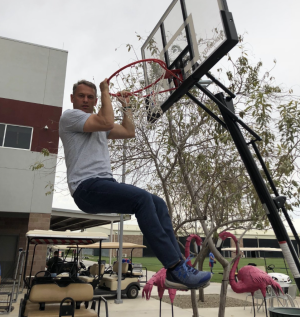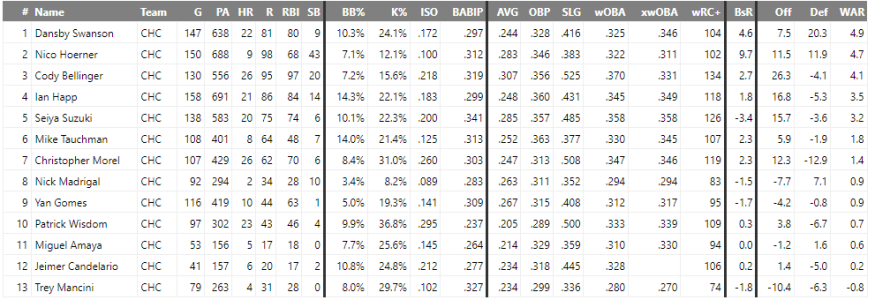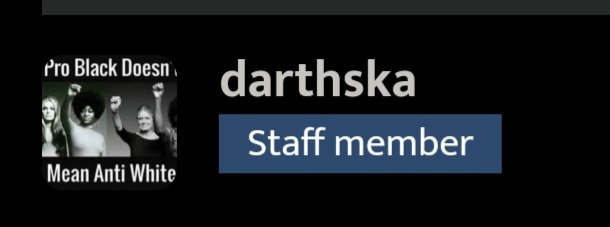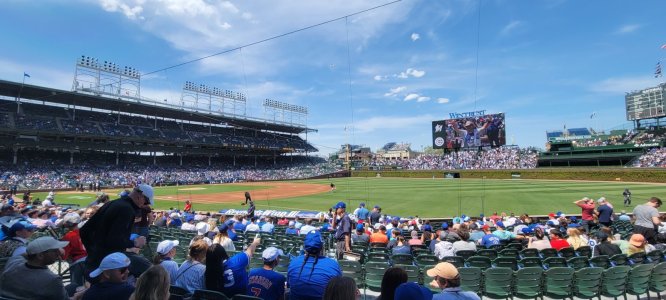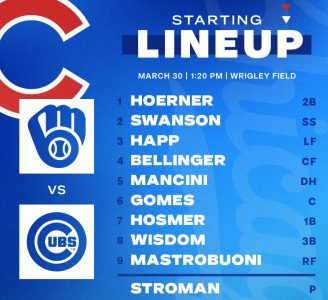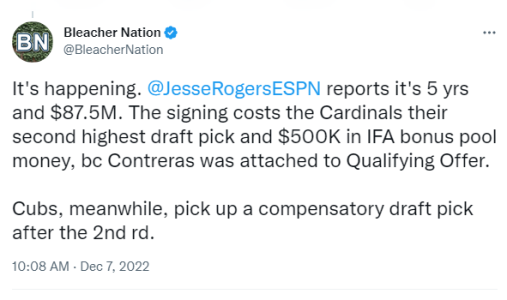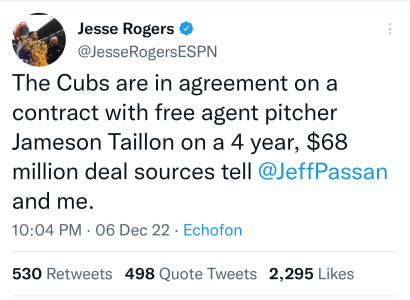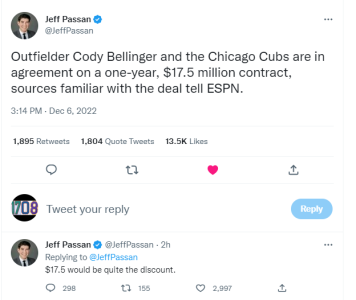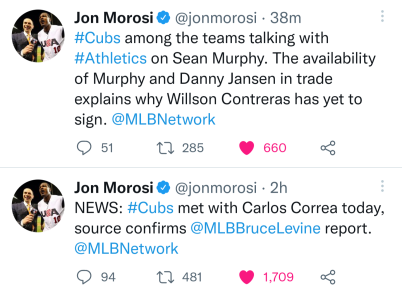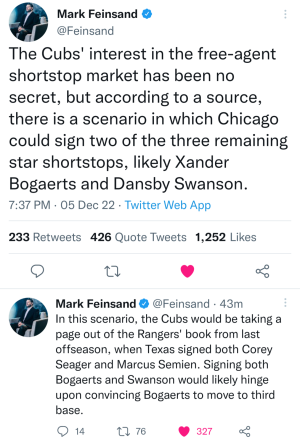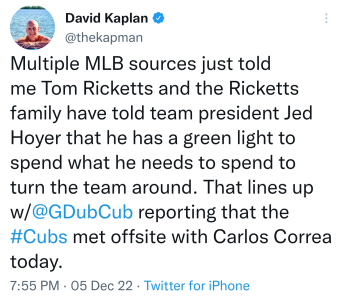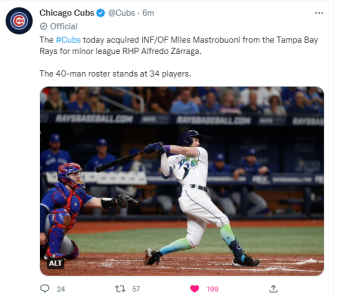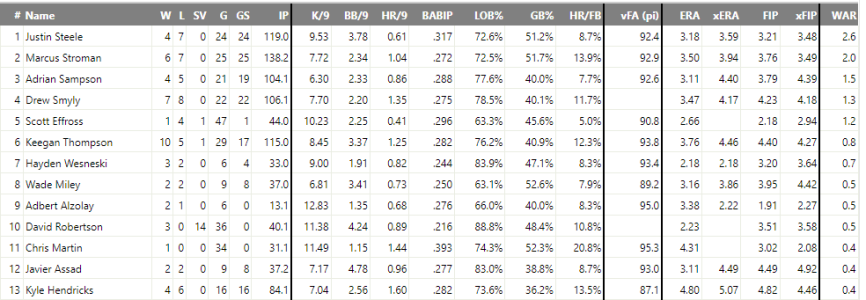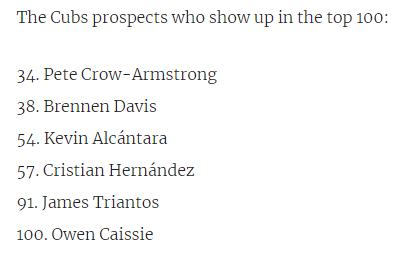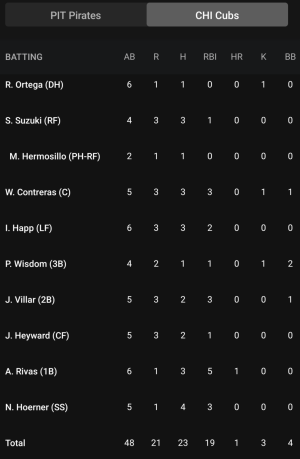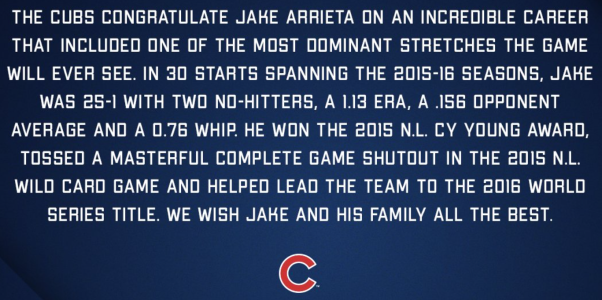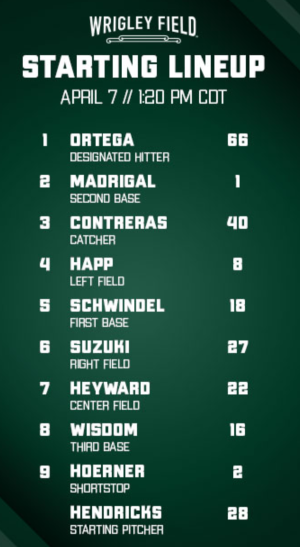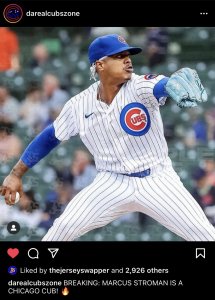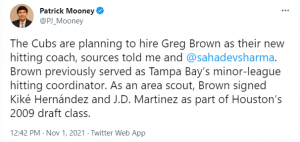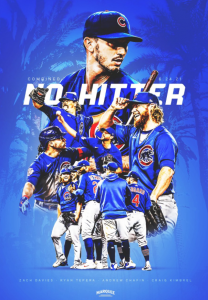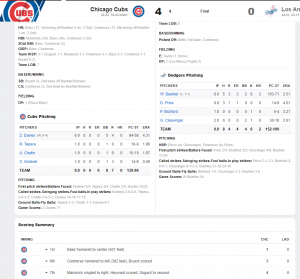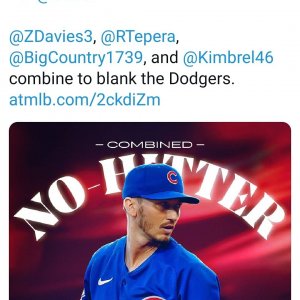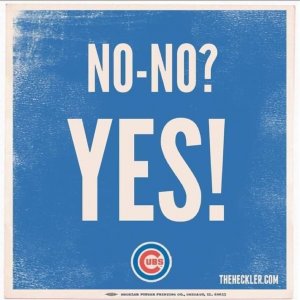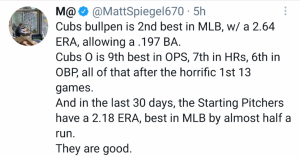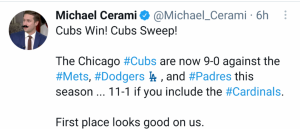With the free agent market so quiet over the last two weeks, and with so many notable free agents still out there, I’m wondering what’s going to happen with Dexter Fowler.
I’m not concerned that he won’t eventually find a good home that pays him well – and it’s important that he does, because the Cubs get a draft pick when he signs*. It’s just a question of where it’s going to be.
Early in the offseason, the teams that were most likely looking for center fielders included the Cubs, the Mariners, the Mets, the Nationals, and the Tigers. The Mariners made a bunch of moves in their outfield and appear set there. The Nationals haven’t been connected to Fowler in any rumors, though they did aggressively go after Jason Heyward. The Tigers picked up Cameron Maybin in trade, and that might be that for them. The Mets have been connected to Fowler at times, but they just signed Alejandro De Aza, and that might be it for them in the outfield, too.
One team out there that makes the most sense to me is the Giants, and Ken Rosenthal reports that he is a consideration there. I think the Orioles also make a great deal of sense, and probably the White Sox, too. The Indians would make sense if they were willing to spend a little bit. There’s an argument that the Rangers could use him in a rotation. Maybe even the Cardinals. That is all to say, there are some teams that make sense, but it could still be a long process for him to find the right spot.
It looks increasingly possible, then, that Fowler – who still looks like a great value on a reasonable three or four-year deal to me – may wind up a bargain signing late in the offseason.
Is there any chance at all that the Cubs, even after signing Heyward, would pounce on a steal of a deal?
Bruce Levine looks at that issue, implying that it’s still possible if the right series of related moves happen. You know the drill on the one you hear most: Jorge Soler gets moved for pitching, and then Heyward plays in right, opening center back up. Setting aside whether the Cubs could even make it work on a bargain deal financially, I think it’s fair to ask just how much the series of moves would actually improve the Cubs. It depends on the pitcher, of course, but, given Soler’s enormous upside, and given Fowler’s arguably mediocre defense in center field, is Fowler-Heyward clearly better than Heyward-Soler? I think there’s a debate there, and it gets really tricky because we don’t know for sure (1) how good Heyward can be in center field, (2) how good Fowler actually is or isn’t in center, and (3) whether Soler can get much better in right.
Then you throw in how tough it would be for the fit to work financially, plus the Cubs’ already-solid rotation for 2016, and this is all very hard to see. Levine mentions the possibility that Fowler would have to settle for a two-year deal in the $26 to $30 million range, and, if that actually happened, it would be so tempting to want the Cubs to sign Fowler simply because that’s a killer deal for a very valuable asset (sort out the details later). But I still think Fowler’s going to get a lot more than that. He should get a lot more than that.
So, in the end, I see the issue as more about whether the Cubs are independently interested in pursuing a Jorge-Soler-for-pitching deal – something Theo Epstein recently suggested was not likely – and then, if that happens for reasons that go beyond solely thinking about 2016, and the Cubs are suddenly looking for a center fielder anyway, maybe we circle back to Fowler being a discussion point around here. I just don’t think targeting a Fowler return is going to be what drives anything else the Cubs do. I sincerely believe the Cubs are happy with Heyward in center for the next year or two, and meanwhile seeing what they have in Soler in right.
Fowler was a perfect addition for the 2015 Cubs. He was a huge part of the team’s success, and, had they not landed Heyward, he would have made a ton of sense to return in 2016 and 2017. As it stands, though, he’ll probably find his best deal elsewhere.
*(A compensatory draft pick after the first round that will immediately disappear because the Cubs lose two picks for signing qualified free agents Jason Heyward and John Lackey. But Fowler signing still nets the Cubs a pick – presently, they’re set to lose their first and second rounders. When Fowler signs, the Cubs lose the compensatory pick instead, so it’s like they’re “getting” that second round pick back.)
Navigation
Install the app
How to install the app on iOS
Follow along with the video below to see how to install our site as a web app on your home screen.

Note: this_feature_currently_requires_accessing_site_using_safari
More options
You are using an out of date browser. It may not display this or other websites correctly.
You should upgrade or use an alternative browser.
You should upgrade or use an alternative browser.
Official 2023 Chicago Cubs Season Thread Vol: (17-17)
- Thread in 'Sports & Training' Thread starter Started by CP1708,
- Start date
- 1,887
- 503
- Joined
- Sep 7, 2011
Keep the updates coming CP. Great articles.
As the Cubs work their way in and out of free agency, we’re constantly thinking of their payroll flexibility. Most often, we consider payroll flexibility for additional, future free agents, but there are a couple of other ways it’s useful. Making trades for expensive players is always a possibility – like Miguel Montero – as is extending young talent that’s already in-house.
As it turns out, the Cubs have a lot of young talent they might want to extend. And while every team in baseball should be envious of the Cubs’ glut of exciting young players, they will probably become less envious eventually, given what they might cost in a few years, especially if the Cubs hope to retain them into their free agent years.
By my count, the Cubs’ young positional core includes seven players (ages in parenthesis): Anthony Rizzo (26), Jason Heyward (26), Kris Bryant (24), Jorge Soler (23), Javier Baez (23), Kyle Schwarber (22) and Addison Russell (21). If you’re having a bad day, just read that list over and over. (And maybe also check out my earlier article on how notable and impactful such a collection can be.)
Anthony Rizzo has already signed an extension that keeps him under team control through 2021, and Jason Heyward has the option of staying for plenty of money and years if he wants, as well. So, after subtracting those two, the Cubs have five young position players that they could arguably want to extend beyond their current team control, and, according to Bruce Levine, the Cubs are keeping those extensions on the mind.
If you recall, Brett took a look at each of the five possible extension candidates a few months ago, apropos of rumored Bryce Harper extension discussions. Everything he said at the time remains true, but this is something we’ll have to constantly keep in mind. Although the Cubs won’t be able to (or necessarily want to) extend each of those five position players, the looming possibility of a few extensions remains. More importantly, which/how many/for how much players are extended will have a dramatic impact on the Cubs ancillary moves in free agency and trades (expanding or limiting flexibility, depending on what the deals look like).
To be certain, none of Kris Bryant, Kyle Schwarber, Addison Russell, Javier Baez or Jorge Soler will be easy to extend. That group consists of four first round draft picks that scored some decent money and one international free agent who signed a large deal that allows him to enter arbitration, as well. Not to mention, two of the above players (Bryant and Russell) are represented by the notoriously successful agent, Scott Boras.
Let’s examine this group in a slightly different way than Brett did before, though. Let’s assume (generously) that all five remaining players perform well over the next two or three years – well enough that extending them would be desirable. Which players might make the most sense to extend from the Cubs perspective, and which might they let play out their current team control?
Kris Bryant is 24 years old (as of yesterday) and has six more years of control, pending the resolution of his service time grievance. By the time he becomes a free agent, Bryant will be entering his age 30 season. While I feel pretty confident that he will still be a successful player at that age (and that the Cubs would love to have him for, say, ages 30-33) he might be the guy most likely to play out his years of team control and then hit free agency un-extended. Given all of the information (his agent, his age, his expected price tag, the service time stuff, and his enormous signing bonus), I’d say Kris Bryant and the Cubs might have six more (hopefully glorious) years together, and then a parting of ways might make sense for both sides. Perhaps if the Cubs were willing to consider an extremely long extension, something could be worked out, but, ultimately, I see a low probability of an extension.
Jorge Soler and Javier Baez are currently 23 years old. Soler will be a free agent after five more seasons and will be 28 years old; Baez will be a free agent after six more seasons and will be 29 years old. Soler has already made a good chunk of change (and is guaranteed much more), and Baez netted a sizable signing bonus, though he’s earned much less than Soler thus far. Given the tentatively injured past of Soler, the age of Baez at free agency (29), and Baez’s guaranteed money so far, this duo represents the “medium” probability of an extension. It could make some sense for each to want to ink a long-term deal. But, from the Cubs’ perspective, the value the Cubs would be getting by extending into the post-control years sooner rather than later might not be as worthwhile as saving the money and spending it elsewhere.
Lastly, we have Addison Russell and Kyle Schwarber. These are the youngest two players, as Russell is scheduled to hit free agency at just 27, Schwarber 28. Extending either of these two players represents the best use of money – based on number of “prime” years being gobbled up. Even if all six of these players were good from now until free agency, all six will eventually decline. All else equal, getting as many of the youngest years as possible is inherently less risky. In that regard, Russell and Schwarber might be the most likely candidates for extensions, at least from the Cubs’ perspective. Spending money on them might return the most bang for the buck.
To address the Russell/Boras connection for a moment, I may have an alternate view of how it could play out than others. As it stands, most believe that Russell will not sign an extension, because Boras will feel that the young shortstop will get more in free agency. While that might be true, I still think the Cubs stand a chance, as you have to always remember that an individual player ultimately dictates his own contractual future. Further, while Russell is uniquely young, there’s no doubt, that could cut both ways in extension talks – for example, because of that, the Cubs might be all the more confident handing out an extension that is closer in value to what he can receive in free agency. If they offer it sooner rather than later – and before his bat breaks out – it becomes all the more possible.
The biggest wrench in all of this is could be the newly-adopted trend of opt-outs in free agency. The future possibility of two prime contracts after leaving the Cubs for Russell, for example, (assuming he opts out of his first free agent deal and scores a second) might be far too valuable for the Cubs to match.*
Whatever happens, if the Cubs so choose, this core will be together for a very a long time. Keeping talent is always desirable, but just about every guy is already under control for six more seasons. The Cubs are set up for sustained success beyond that, as well, and maybe we’ll come to find that there’s a certain window for this group before a new group ushers in the next era. We’ll see how the sides proceed.
Still, these types of extension discussion typically occur after free agency dries up and Spring Training approaches (the players are often too busy during the season and the front office is often too busy after). So keep an eye out and an ear to the ground, because if any extension discussions are going to happen, they might happen soon.
*(Of course, the Cubs could offer an opt-out and/or a player option year or two in an extension, themselves, but that’s a conversation for another day.)
CHICAGO (CBS) — A long-range plan to keep the players they have and stave off a $200-million payroll is on the Chicago Cubs’ mind already.
President of baseball operations Theo Epstein and general manager Jed Hoyer have done a quality job of tying up valuable assets at past stops, weighing both the importance of players against how much money they will earn over the next seven to 10 years.
It’s simple to say but worth reminding in today’s day and age of exploding salaries: Getting young players signed for the long term is vastly underrated when building a winner.
The Cubs signed first baseman Anthony Rizzo to a seven-year, $41-million contract in May 2013 in a deal that included a $2 million signing bonus. Rizzo average annual salary is just shy of $5.9 million through 2019. The Cubs can control Rizzo two more seasons after that, as they hold club options in 2020 and 2021 at $14.5 million in each season. If those are exercised, that would make the nine-year average of his contract $7.8 million.
The Rizzo deal is an absolute deal for the franchise, as evidenced by his 2015 season in which he hit .278 with 31 homers, 101 RBIs and an .899 OPS.
In an era where the best players will soon be making $40 million a season, this type of progressive signing by the Cubs locks in a perennial All-Star for at least $150 million under market value. Those numbers on a long-term contract — based on the market projection of a 26-year-old top run producer like Rizzo or 23-year-old Nationals outfielder Bryce Harper — can be a total game-changer.
These essential projections for big league franchises analyzing the future costs of their product on the field will separate the teams with flexible payroll systems, after revenues peak on local television deals. The television deal bubble won’t last forever.
The Cubs will easily be able to handle a $200-million payroll when they get new TV money for 2020 and beyond. That $200-million figure seems like a ton of money, but with escalating player salaries, that may be the median payroll figure for a 25-man roster in three to five years. With Kyle Schwarber, Kris Bryant and Addison Russell under team contract control for six more seasons, the Cubs are in an enviable position but would still like to get some youngsters signed beyond that.
Arbitration after three big league seasons for each player will inflate contracts in its own way. What the Cubs would like to do is project out and sign their best young players through a couple of their free-agent years — which is sometimes referred to as “buying out” free-agent years.
The price for a superstar slugger in five years could be $45 million per season. That figure may sound like inflated, but when you consider that Diamondbacks right-hander Zack Greinke is already receiving $34 million annually over the next six seasons, you see that as reasonably attainable figure for the best players.
The uncertain variable in the “sign them early” campaign regards agent philosophy. Both Bryant and Russell are represented by Scott Boras, a pragmatic hawk as far as MLB owners are concerned. He has been the driving force for the players’ union keeping the needle going up on player salary for 25 years.
Boras doesn’t like his players signing early deals before free-agent status occurs, though it’s worth noting it still happens occasionally. Therefore, getting the Cubs getting Bryant and Russell under moderate contract control may be difficult. It’s the leading support for why the Cubs front office delayed Bryant’s call-up to the big leagues last April — they wanted the extra year of control on the back end of his contract, because that could be worth $45 million or in the early 2020s.
The collective bargaining agreement between the players and owners ends this coming December. Part of the conversation will be about runaway payrolls and ways to legally ****** the escalation of players salaries. The owners were hit with a $280-million collusion penalty in 1990 for years of 1986 and 1987. That would be peanuts by today’s standards if the owners were ever accused of acting in unison on offering or not offering contracts.
Needless to say, the way the Cubs handled the contract dealings of Rizzo and former infielder Starlin Castro’s (seven years at $60 million total) have enabled them to sign two star players for a combined $339 million over the past two seasons — left-hander Jon Lester at $155 million in December 2014 and outfielder Jason Hayward at $184 million this past December.
This type of creative prognosis in projecting players values will continue on both sides of town, as the White Sox have also been brilliant in giving out dirt-cheap deals to left-hander Chris Sale, left-hander Jose Quintana and outfielder Adam Eaton.
How does Cubs shortstop prospect Gleyber Torres compare to Addison Russell?
-- Ken M., Tampa, Fla.
An extremely precocious hitter, Torres batted .293/.353/.386 as an 18-year-old in the pitcher-friendly Class A Midwest League this season. He's currently the Cubs' best prospect, an honor that never belonged to Russell because he was one spot behind Bryant as they rose through the system together.
As talented as Torres is, he doesn't figure to dislodge Russell from shortstop at Wrigley Field. Comparing their tools, they're similar hitters and have comparable speed, but Russell has more pop and is a better defender at shortstop. Though Torres has the stronger arm, he's probably destined for second base if he remains with the Cubs.
1. Gleyber Torres, SS
Current Level/Age: High-A/19.1, 6’1/175, R/R
Acquired: Signed in 2013 out of Venezuela by CHC for $1.7 million bonus
Previous Rank: 9
Torres has a great all-around profile, with all but his power projecting to be at least average. Defensively he doesn’t have prototypical shortstop range, but controls his body extremely well with excellent footwork. If he loses a step as he matures, he would be a great fit at second or third, as well, but I like him at short. He has plus arm strength with the ability to get rid of the ball quickly. His average speed could fade, but he has the instincts to create opportunities on the bases regardless.
In the box, Torres has a line drive swing with a lot of athletic moves. He makes plenty of hard contact, though his strength and level swing plane hint at a power ceiling around average. His batting practice swings show some better lift, but reaching it against live pitching would likely require some conscious effort to enact, made unnecessary by his raw ability to hit.
He has excellent balance and a strong lower half, with smooth hands and a selective approach in game. There is work to do on pitch recognition, but that is likely to come with more repetitions rather than being an innate problem. Torres looks to me like an elite major league hitter who will have situational power, making pitchers pay for mistakes left up in the zone.
Hit: 40/60/70 Power: 25/40/50 Run: 50/50/55 Field: 55/55/60 Throw: 55/60/60
Overall (Current, Likely Future, Ceiling): 35/60/70
2. Ian Happ, OF
Current Level/Age: A/21.7, 6’0/205, B/R
Acquired: Drafted 9th overall (1st round) in 2015 out of U of Cincinnati by CHC for $3 million bonus
Previous Rank: NA
Happ broke out in a big way this year at Cincinnati after two strong summers in the Cape Cod League, offering an intriguing power-speed combination on offense. His defensive skills were deemed by the Cubs to be better suited for the outfield, an understandable tactic to allow his bat to get him to the big leagues as quickly as possible.
In the outfield, he has fast footwork and a quick release, though his body control is a bit below average. Attempting to make difficult plays in the infield is a tall order, but in the outfield he has more time to work around balls and get into good position to make plays. It’s possible he’s at best an average fielder, but I think he projects well enough to play a passable center field or a good corner. His above-average arm plays up due to his quick release time.
Happ’s lefty swing has more power potential than his right, with tons of natural lift and bat speed. From the right, he swings downward or level more often, but he should still do enough damage from his lesser side. The only questionable part of his hitting is his contact. Happ has some issues barreling up balls when he gets too pushy with his hands, leading to poor barreling. He swings and misses at a lot of pitches, often enough that his strikeout rate may continue to rise as he climbs levels.
Despite some reservations on his hit tool, he has sufficient positives to outweigh any negatives that remain after more repetitions and development. The contact he does make will be hard enough to make it work, and he’s shown the ability to take his walks when given nothing to drive. Even if Happ ends up in a corner outfield spot, he can produce enough with the bat and on the bases to be a valuable starting player.
Hit: 40/50/55 Power: 45/55/65 Run: 55/55/60 Field: 45/50/55 Throw: 55/55/60
Overall: 45/55/65
3. Duane Underwood, RHP
Current Level/Age: High-A/21.7, 6’2/215, R/R
Acquired: Drafted 67th overall (2st round) in 2012 out of Georgia HS by CHC for $1.05 million bonus
Previous Rank: 7
Underwood continued building on his solid 2014 this season at High-A Myrtle Beach, until an elbow injury forced him to miss two months of the season. He came back in August to make six starts and pitched well to close out the year. Though concerns about his makeup and maturity are still fresh in evaluator’s minds, he has done well to stay in shape and improve his command the past two seasons.
He throws a mid-90s fastball with room for more when he reaches back, and gets excellent running action. Though his curveball is his best secondary pitch, he spent much of 2015 working on his changeup, which remains a work in progress. The curve flashes better than plus, but it still has inconsistent tilt depending on his release.
Underwood almost jumps toward the plate in his delivery, but does a great job repeating his delivery and maintaining balance. There is a lot of momentum left over in his arm at his finish, and his arm recoils pretty hard after release. If he’s truly grown up now, the elbow injury and extra reliance on his arm in the delivery are really the only blemishes in projecting Underwood.
Assuming good health, he has the ceiling of a number two or three starter, likely settling into the middle of a rotation if his changeup doesn’t develop enough.
Fastball: 50/60/65 Curveball: 55/65/70 Changeup: 40/45/55 Command: 50/55/60
Overall: 45/55/65
4. Dylan Cease, RHP
Current Level/Age: R/20.3, 6’1/175, R/R
Acquired: Drafted 169th overall (6th round) in 2014 out of Georgia HS by CHC for $1.5 million bonus
Previous Rank: 20
As one of the hardest-throwing high school pitchers in the draft, Cease’s elbow injury was the only reason he was available after the first round. The elbow injury led to Tommy John surgery, and it wasn’t until 2015 that he was able to throw his first professional pitch. Reports of his stuff in the rookie Arizona League this year had him sitting 95-96 with his fastball, an uptick from his high school days pre-surgery.
Before the draft, Cease had some obvious mechanical issues that put undue stress on his quick arm. He literally jumped toward the plate, and his hips slid out from under him toward first base, rendering his arm as the only means of propelling and controlling his offerings to the plate. He had enough lower body strength to hold his balance despite the rough directional issues. His finish was different every pitch, and there was a noticeable arm “clang” as his follow through slammed into the left side of his body.
Fast forward to 2015, and he has considerably improved from a mechanical aspect. Gone is the hip slide, with Cease now finding much better footing and an ability to use the ground to support his arm. His command sharpened, particularly with his fastball, and his delivery has a more repeatable look than previously observed.
He throws a curveball and a changeup to round out his arsenal. The curveball has flashed better than plus in the past, though its shape and command still need work. His changeup is a serviceable third pitch, but its projection really depends on his other two offerings reaching their potential to be better than average.
Seeing him as an amateur, I would agree with most scouts who believe he may end up in the bullpen to protect his arm and hide the command issues he had. With 2015 in the books, Cease took such big steps forward in his recovery and first outings in the Cubs system that I believe he continues developing into a starter. A number three or four role is a likely outcome even if his curve and command do not reach their ceilings.
His ceiling is even higher, with an improved delivery boding well for the progress of his curveball consistency. I hedged a little bit with his ceiling grade on account of his limited experience and the elbow injury, but Cease has the potential to be at the top of a big league rotation. His 2016 season should give us a better idea of how good he actually will be, as he learns to pitch rather than blowing hitters away with his velocity. His overall command and his curveball consistency being the biggest things to watch.
Fastball: 55/65/70 Curveball: 40/55/65 Changeup: 35/45/55 Command: 40/50/60
Overall: 40/55/65
5. Billy McKinney, OF
Current Level/Age: AA/21.6, 6’1/205, L/L
Acquired: Drafted 24th overall (1st round) in 2013 out of Texas HS by OAK for $1.8 million bonus, traded to CHC 7/2014
Previous Rank: 10
McKinney came to the Cubs along with Addison Russell in the 2014 Jeff Samardzija trade, and he hasn’t stopped hitting since. He’s a big guy with obvious strength, though the power has been slow to develop. Regardless, he makes up for it with his ability to hit and get on base at a high level.
He projects well in a corner outfield spot with average speed and good instincts, though his defense will be around average to a bit below there. He draws positive reviews for his instincts, allowing for the possibility of his tools playing up a bit on defense. Though he has average speed, stealing bases isn’t a big part of his game. He will likely continue using good baseball sense to be a decent contributor as a baserunner overall.
At the plate, McKinney really shines. He makes a lot of contact and has a consistent, selective approach. His swing path gives him a lot of room for error on off speed pitches, and he creates enough lift to drive a ton of balls in the gaps. There is not much torque in his swing; instead, McKinney settles for squaring balls up and doing more work with his upper body in a smooth, athletic motion. His actions suggest some added strength or an attempt to create more lift might raise his power ceiling quickly, but I’ll settle for likely average power.
McKinney has a high floor on account of his hit tool alone, and he’s good enough in the rest of his game to project easily as a starter in the big leagues. He looks more like a dangerous doubles hitter than homer threat, but those play at any level, too.
Hit: 50/65/70 Power: 40/50/55+ Run: 45/45/50 Field: 45/50/55 Throw: 45/45/45
Overall: 45/55/65
6. Dan Vogelbach, 1B
Current Level/Age: AA/23.3, 6’0/250, L/R
Acquired: Drafted 68th overall (2nd round) in 2011 out of Florida HS by CHC for $1.6 million bonus
Previous Rank: 11
Vogelbach struggled with hamstring and oblique injuries in 2015, limiting his total at-bats and power numbers in Double-A. His swing was noticeably affected by the maladies, and he was forced to hit without much use of his lower half the entire year. Despite the limitation, Vogelbach posted impressive marks in the on-base department, maintaining stellar walk rates in a down year.
His defense and running speed leave him almost assuredly in a DH role, but the bat is worth a starting role in the future. His swing is built for loads of line drives and fly balls, and he has enough contact ability to make his bat profile at a high level. When healthy, he shows great athleticism at the plate, with exceptional sequencing throughout his swing, great balance, and a hand path that stays on the ball as long as physically possible.
I think it’s too easy to look for a reason why Vogelbach won’t succeed given his body type, and his fall in other rankings is a mistake on account of his bat. This guy is an excellent hitter in the making that had injuries sap his power, not a fringy power hitter who had a setback year. Just look at two of the greatest hitters on the planet who dealt with nagging injuries, Miguel Cabrera (ankle/calf in 2014-15) and Joey Votto (quad in 2014), for how much a lower half injury can affect power output. Team officials say he should be 100% healthy for 2016.
His ranking here might be going out on the limb that he can keep his body in check, which I believe is directly tied to his ability to stay on the field. His total value is limited by the lack of position, but he has the ceiling of a feared power hitter in the middle of any order. The on-base skills bump his hit tool up half a grade across the board.
With first base locked up by Anthony Rizzo, it’s easy to envision Vogelbach excelling in the minors to start the year before being dealt to an American League team for major league reinforcements, where he can really flourish. Cubs sources applauded his serious approach to his conditioning, and they believe he may end up being serviceable at first.
Hit: 50/60/65 Power: 50/55-60/65 Run: 20/20/25 Field: 30/30/35 Throw: 40/40/40
Overall: 45/55/60
7. Oscar De La Cruz, RHP
Current Level/Age: Low-A/21.1, 6’2/180, R/R
Acquired: Signed in 2012 out of Dominican Republic by CHC for $85,000 bonus
Previous Rank: NA
De La Cruz has only been pitching since he was signed in October 2012, with the Cubs converting him from his natural shortstop position as a professional. He has made the decision look genius so far, spending the 2015 season in Low-A Eugene with excellent results. He boasted a 73:17 strikeout-to-walk ratio in 73 innings. Multiple team sources had him close to their personal top-five lists, but I would like to see more development of his offspeed before going too crazy on him.
Commanding the fastball is his best asset on the mound, able to keep it in the zone with low to mid-90s velocity and decent life. He’s developing his secondary pitches, which will be essential for when he starts facing better overall hitters. He should continue getting lower minors hitters out by attacking them with fastballs, but look for his curve and change to step forward for him to see his ceiling.
He is a big, athletic pitcher who the Cubs believe will be a very durable rotation member as he continues building up innings. De La Cruz gets high marks as a great competitor, and 2016 should be an exciting year to see how well he improves his offspeed pitches as the competition gets better. Having such great command of the fastball at a young age makes his floor pretty high, though I want to see where his other offerings go over the next 12-24 months before buying in as a frontline starter.
Fastball: 45/55/65 Curveball: 40/50/55 Changeup: 35/45/50 Command: 40/50/60
Overall: 40/50/60
8. Mark Zagunis, OF
Current Level/Age: A+/23.2, 6’0/205, R/R
Acquired: Drafted 78th overall (3rd round) in 2014 out of Virginia Tech by CHC for $615,000 bonus
Previous Rank: NA
Zagunis has surprising athleticism in the outfield, having been converted to the outfield as a former catcher. The Cubs valued his unique on-base abilities too much to let the defensive work slow down his progression. Zagunis still has interest in catching, and Cubs management has left the door open to coming back to it at some point.
He demonstrates solid-average speed and is aggressive on the bases, leading team sources to believe he can handle all three outfield spots. He likely fits best in the corner positions. He may not steal for a ton of bases but shows enough instincts to be about average or a bit below as a baserunner.
Zagunis is an interesting hitter to project as a big leaguer. He has a superb eye at the plate, makes plenty of contact and has a swing path conducive to hitting balls in the air. It’s tempting to believe he just needs to grow into some man strength for the power to come, though he doesn’t have much physical projection left in his frame.
Also complicating his power prospects are minor swing issues. His swing path does hint at consistently hitting balls over the outfielders and sometimes the fence, but his swing as a whole lacks the torque and explosiveness you’d like to see from a power prospect. Oftentimes he gets stuck on his back leg when he reaches out with the front foot rather than taking a true stride. This unbalanced landing position makes his hips spin rather than really drive into the pitch.
Despite the power questions, his hit tool should carry him into a starting role with close to average tools across the rest of the board. His discerning eye gives him a sizable bump to his hit tool. Zagunis should develop just enough power for pitchers to have to work around him, giving him plenty of value in the outfield. The Cubs believe in his power coming around, though most sources I spoke with wouldn’t have him this high in the rankings.
Hit: 50/60/65+ Power: 35/40/45 Run: 45/45/50 Field: 50/55/55 Throw: 50/50/50
Overall: 40/50/60
9. Willson Contreras, C
Current Level/Age: AA/23.9, 6’1/175, R/R
Acquired: Signed in 2009 out of Venezuela by CHC for $850,000 bonus
Previous Rank: NA
The big improvement in Contreras’ development this year was his plate discipline, cutting his strikeout rate nearly in half after graduating to Double-A. With his mastery of the strike zone came a ton of walks and an equal increase in opportunities to drive the ball, leading to a .333 and .413 batting average and on-base percentage, respectively. Still developing defensively, he has enough positive traits to look like a big league catcher, but I have some minor doubts about him becoming an average producer overall at the position.
Though Contreras has a strong arm, his pop times can be inconsistent due to fast but shaky footwork. Some of the throws I saw from him in the Arizona Fall League featured plus times with good accuracy, while many others ended with the ball fading off toward the first base side of the bag at below-average times. He has the upside to be an above-average defender, but it will take more work cleaning up his receiving and solidifying his footwork to reach his ceiling. Club sources were higher on his defense, believing in his arm as a consistent weapon on defense.
In the batter’s box, he demonstrates well above-average exit speeds with a big, fast swing, which I found surprising given the contact ability he proved this year. He can look rather raw at the plate despite a solid mental approach, with his hand movements occasionally getting too big and his swing having an all-at-once look that could get exploited by big league pitchers. He showed how smooth he can be when everything was timed up, but the inconsistency makes his likely future hitting grade a tick or two lower than what it can be at his best.
Catchers are supposed to take the longest to develop fully, and Contreras’ chances of reaching his ceiling as a plus catching option will be a test of that received wisdom. That he performs at a high level only in flashes, and is likely to end up at Triple-A this year (thus shortening the window on his development time), probably mean that he’s less likely to reach his full defensive potential. I can’t help shake the feeling he ends up slightly below average overall, but his potential makes it difficult to put him lower on this list. Team sources put him in their top five, citing his Double-A batting title as a huge reason for optimism.
Hit: 45/50/60 Power: 35/40/50 Run: 40/40/45 Field: 45/50/50 Throw: 45/50/60
Overall: 40+/50/55
10. Albert Almora, CF
Current Level/Age: AA/22.0, 6’2/180, R/R
Acquired: Drafted 6th overall (1st round) in 2012 out of Florida HS by CHC for $3.9 million bonus
Previous Rank: 5
Almora is one of the few upper-level prospects in the system that didn’t take a huge step forward in 2015, but still made improvements that keep him on track for a shot in the big leagues. He’s a pretty safe bet for plus production on defense as a true center fielder with excellent range and a strong arm. He possesses above-average raw speed, but hasn’t taken any strides to convert it into usable ability on the basepaths, at least in terms of stolen bases, but he will still be at least an average baserunner.
At the plate, Almora has an aggressive approach that leads to a lot of contact with raw power that hasn’t translated to the game side. He has a level to choppy bat path, and he has had issues with barreling the ball up at times, but he does enough well in the box to project as at least an above-average bat in the big leagues. I haven’t seen anything in his swings to expect much more than below-average power, especially since it’s unlikely he gains enough raw strength to drive the ball in the air with his swing path.
He deserves a lot of credit for improving his approach in 2015, and even if he hit for no power he is still viable as a big league option on account of his hit tool and defense. If he can further hone his plan at the plate and consistently pick out good pitches to drive, Almora could be a legitimate top-of-the-order hitter while playing great defense. He still has some rawness to work out, but I see no reason not to expect Almora in a major league outfield in a year or two.
Hit: 45/55/60 Power: 35/40/45 Run: 50/50/55 Field: 60/60/65 Throw: 60/60/60
Overall: 40/50/55
45+ FV Prospects
11. Ryan Williams, RHP,
Drafted out of Eastern Carolina as an under-slot sign to accommodate other picks in his class, Williams has put up awesome numbers in his first 168 innings across four minor league levels. He doesn’t have a definitive strikeout pitch, but his command and control both could be plus, making him an option for the Cubs staff as soon as this year. Matched with elite makeup and an advanced comfort with properly executing game plans, Williams has some sleeper potential as a mid-rotation starter.
There is nothing flashy about his actions on the mound, which features a consistent, simple delivery. He doesn’t have the loosest arm action in the world, but it is low stress enough that his future command and health outlooks are good. His best pitch is a heavy sinking fastball that sits 88-91, which he commands well in the bottom of the zone. His repertoire includes a curveball, slider, and changeup that all have fringy movement but are spotted very well, making them all potentially play up to at least average.
He pitched mostly in long relief in college, and it’s possible his stuff relegates him there in the big leagues. I think his pitching skill makes him a solid bet for at least a back-end rotation role with underappreciated upside. The Cubs will obviously keep him in the rotation as long as possible, and sources offer praise for Williams consistency going deep into games with low pitch counts.
I was really tempted to bump him higher on this list, but I would like to see one of his secondary pitches show enough movement to get swings and misses before going crazy. Williams is likely to find himself in Triple-A to face hitters who are better able to stick to their own plans, so 2016 should give us a good look at what his future holds.
Fastball: 50/55/60 Curveball: 45/50/55 Slider: 45/45/50 Changeup: 45/45/50 Command: 50/55/60
Overall: 40+/45-50/55
12. Jeimer Candelario, 3B,
Candelario had a huge bounceback year in High-A and Double-A after some struggles in 2014. He showed some of the best power of his minor league career, driving doubles from both sides of the plate. He excelled against Arizona Fall League competition, taking his hard-hitting ways to another level.
At third, he has improved enough to have no problem sticking at the position in the future. He won’t be much of a contributor on the bases, and is likely to continue slowing down as he fills out his frame some more.
Candelario may end up being a better hitter overall on the right side of the plate, though most of his power has come from the left. He has a very quick bat on both sides, though he tends to roll his barrel through the ball, particularly on the left side. When he catches the ball on the barrel, it really jumps off the bat to his pull side, but he will need to show more feel at the plate to tap into his raw strength consistently. His swings on both sides are built for line drives and gappers, though he may naturally add some power as he matures physically.
When things go right, he has the tools to be an exciting above-average big league player. Lingering approach concerns and some swing issues cloud his future as a trusted starting option for me, but I think his bat speed and contact will keep his batted ball quality high enough to be close to an average regular.
Hit: 40/50/60 Power: 40/45/55 Run: 35/35/40 Field: 45/50/50 Throw: 55/55/55
Overall: 40/45-50/55
13. Jake Stinnett, RHP,
Stinnett had a respectable first full year in pro ball, though by the standards he set with his college and pro performances in 2014 it was something of a letdown. He had trouble getting his delivery working for most of the year, and his command suffered as result. His power stuff still made regular appearances in his starts, particularly toward the end of the year, and the Cubs are looking forward to Stinnett having a year where expectations won’t be as high.
His fastball works in the low to mid-90s with great run and some sink, though he can reach up to 97 with a flatter offering. He throws a slider that can be almost unhittable down in the zone, and a changeup that should end up working for him as a close to average pitch. Despite having trouble with his rhythm this year, Stinnett has a great frame with really athletic actions on the mound. He has a super clean arm and delivery when he’s right.
Already 23 years old, it’s important to point out he’s only been pitching since his junior year of college in 2013, so needing to develop some of the finer skill work is completely expected. In his case, I really believe in the athlete and the stuff working out in the end.
This season will give us a better picture of what he can be, but I think he ends up jumping up prospect lists in short order by next offseason. He won’t be rushed through the system despite his age, being treated as a younger arm due to lack of experience. I am holding his middle projection down a bit for now, but his ceiling may be as high as the top pitchers in the system.
Fastball: 45/55/60 Slider: 45/55/65 Changeup: 40/45/50 Command: 40/50/60
Overall: 35/45/60
14. Carl “CJ” Edwards, RHP,
After spending much of 2014 on the shelf with shoulder inflammation and fatigue, Edwards transitioned to a bullpen role full-time in 2015 with mixed results. Spending time in Double-A, Triple-A and the majors, his strikeout rate jumped to well over a batter per inning, but his walk rate also climbed to dangerous levels. He continued his impressive record of limiting home runs, only giving up one in 60 innings, just his third allowed in his professional career.
Edwards brings a hard fastball with cutting action and a sharp-breaking curveball to the mound. His changeup showed some signs of being close to an average pitch, but he mostly focused on his best two offerings in the pen last year. The fastball has the ceiling of a plus or better pitch, with the natural cut making it very difficult to square up. His curve has similar potential, though his fastball is his bread and butter.
What limited him in 2015 was his command and control, particularly with the fastball. He struggled to find the zone, but was effective enough in the strikeout and homer departments to post solid run prevention numbers. I want to see how his command looks in 2016 before really buying into his future as a shutdown reliever.
I worry some about his shoulder issue from 2014, since he has a very abbreviated follow through that relies a lot on the muscles in his upper back to decelerate his arm, rather than a more relaxed, full-body finish. While he had a healthy season, I will be really interested to see if his control and command come back in 2016, or if he’s lost some feel after relying on an inefficient mechanism to slow down his arm for so long.
While there is still some talk of him returning to the rotation, the Cubs plan to keep him in the bullpen, where they really liked what he showed late in the year. Until he can show improvements in his control, his likely future takes a step back for me, though his ceiling remains unchanged. Big league hitters will be able to hit more of his mistakes and lay off pitches out of the zone, but there’s a chance 2015 was just a blip in an otherwise extremely promising pitcher’s young career.
Fastball: 50/55/65 Curveball: 45/50/60 Command: 40/45/50
Overall: 40/45/55
15. Pierce Johnson, RHP,
Johnson’s biggest accomplishment this year was cutting down on his walk rate in Double-A, though his strikeouts dipped below seven per nine in 2015 for the first time in his professional career. His season got a late start because of a lat strain suffered in spring training, and he has had elbow issues in his past. While he has the raw stuff to be a mid-rotation starter, I have questions about his command and injury history that may relegate him to the bullpen long-term.
My concerns over his future command and injuries relate to his delivery. He has an easy-going approach with fairly repeatable mechanics, but he has inconsistent arm actions at and after release that affect his location and stress on the arm. Instead of a clean transfer of rotation from the shoulder down through the forearm into pronation, Johnson cuts off his finish right after release, particularly on his breaking ball. I worry about his ability to continue developing feel for his arsenal, which would conceivably limit him to bullpen duty.
To his credit, Johnson has improved his strike-throwing, and may end up keeping enough pitches in the zone to stay in the rotation. Strikeouts may only show up after transitioning to the pen unless his decent control progresses into above-average or better command. Right now, I think he comes a bit short, but his pure stuff gives him potential in the late innings out of the bullpen, or as a back-end starter.
Fastball: 50/55/60 Curveball: 50/55/60 Cutter: 40/45/50 Changeup: 40/45/50 Command: 40/45/45-50
Overall: 40/45/55
16. Rob Zastryzny, LHP
Zastryzny can be feast or famine depending on the day, with his stuff and command fluctuating from below-average to plus. I saw him in Arizona on one of the good days, coming away very impressed with his arsenal and command. He looked like a future mid-rotation starter, though his historical inconsistency makes it less likely he reaches that ceiling.
On the mound, he had a real fluid arm with a solid base and loose, athletic actions. All four of his pitches showed at least average potential and the command to match. His fastball sat in the low-90s, complemented by a changeup and slider in the high-80s and curveball just under 80 mph. In the past, Zastryzny has gotten too cross-fire with his stride, leading to pitches left up in the zone. He showed that tendency on a few pitches in Arizona, but they were rare.
I split the difference on his likely future role, since it’s hard to ignore what he showed in the fall. Whether his performances will continue to be up and down or if he’s cleaned up the direction in his delivery as a more permanent change will have to be monitored in 2016. He still projects as a back-end starter with his longer track record weighing heavily, but his ceiling may put him solidly in the middle of a rotation with continued development.
Fastball: 45/50/60 Curveball: 40/45/55 Slider: 40/45/50 Changeup: 45/55/60 Command: 45/50/60
Overall: 40/45/55
17. Eddy Julio Martinez, OF,
Martinez was picked up out of Cuba for $3 million after some runaround with the Giants, Cubs and Jimenez’ Dominican and American representatives. He was rated the top international prospect by many outlets before officially signing. Martinez shows some natural ability to lift the ball to all fields, but his swing looks to be geared toward more line drives and gap shots at present.
The Cubs believe he has usable tools across the board with strength and say he has solid-average running speed. Other opinions have him a bit higher on his running ability, and you can also hear scouts say he projects for home run power to all fields. This year will help parse things out, and we can see a bit more of where he really is tool-wise. The team is in no rush to push him developmentally, and will likely let him start in Low-A Euguene to get acclimated.
Hit: 45/50/60 Power: 35/45/55 Run: 55/55/60 Field: 50/55/55 Throw: 60/60/60
Overall: 35/45/55
18. Bryan Hudson, LHP,
Drafted in the third round this past June, Hudson is a towering lefty, standing at 6-foot-7. He gets good reviews for his curveball, showing a better feel for it than even his fastball. He’s more projection right now than product as a multi-sport athlete in high school, and the Cubs will be counting on him learning to use his long frame to create more velocity and command the ball. Team sources say he has gained 20 pounds since signing.
His fastball sat in the upper-80s for most of his senior year in high school, but reports from the team have him 91-93 in instructs. Though his ceiling is pretty high, he has a lot of work to do on his delivery, command, and changeup to dream of reaching it. His command is iffy at best, and he doesn’t have the cleanest mechanics on the mound, with a very arm-dominant delivery. While he’s an athletic guy overall, his sequencing and direction are not where they need to be yet, though pitchers of his size should be given a bit of leeway since it can take longer to figure things out.
For now, he settles in with a back-of-the-rotation projection, though it very easily could go up or down after seeing how his maturation goes the next few years. I’m tempted to take the under on it already, simply because the projection is more based on his size than his actions, but recent reports point to a legitimate upside.
Fastball: 45/50/60 Curveball: 45/50/65 Changeup: 35/40/50 Command: 40/45/50
Overall: 35/45/55
19. Eloy Jimenez, RF,
While still raw two seasons into his minor league career, Jimenez profiles as a solid offensive outfielder given enough time to develop. He received the highest bonus from the Cubs during their 2013 international shopping spree, then produced two impressive platform years in the low minors as a teenager. The biggest thing the Cubs were happy about this year was him staying healthy and playing everyday, allowing him to get into a routine that will help his skill work on both sides of the ball.
An average runner, baserunning is not likely to be a big part of his game as he fills out. He won’t hurt you on the bases, but it will be put to better use on defense. Team sources think he’ll be an average left fielder as he fills out physically, though his arm should be strong enough to help in either corner.
In his swing, his bat flattens out as his swing starts, which he manages by running his hands across his body toward the left side to get the barrel to the ball. He also has a tendency to be choppy and dive for the ball with his upper body slightly, especially when fooled. At his experience level, repetitions against professional pitching should make him more comfortable and able to create more consistent lift.
Jimenez has also shown impressive contact and strikeout rates at a young age, boding well for his future power and general hitting development. He has some work to do to turn the corner as a complete hitter, but he’s shown impressive strikeout rates in the early going to pair with his power potential. He has plenty of time to develop, and his trajectory to the big leagues will be determined by learning to hit without being too “wristy,” and trust his bat. He should start the 2016 season in Low-A Eugene.
Hit: 30/50/55 Power: 30/50/60 Run: 45/45/45 Field: 45/50/50 Throw: 50/55/60
Overall: 30/45/55
20. Darryl Wilson, OF,
Wilson was a high-bonus fourth round pick in 2015 with a fast-twitch body and plus speed. He uses that speed very well in center field, getting good reads and projecting to stay at the position long-term with at least plus upside. He also runs the bases well and should contribute plenty of value taking extra bases.
Everyone I talked to in the organization came away from instructional league talking about his surprising pop. He does have well above-average bat speed, though in game situations he has more of a contact approach that won’t offer much power. He doesn’t have much lift to his swing path, though he is young enough that he may be able to tap into his raw strength over the next few development years. His game is good enough overall that he probably won’t need to hit for power to be a useful big league player.
Hit: 35/50/55 Power: 20/30/35 Run: 55/60/65 Field: 60/60/65 Throw: 50/50/55
Overall: 30/45/50
21. Christian Villanueva, 3B,
Villanueva put together a decent year in his second season with Triple-A Iowa, cutting down on his strikeouts and knocking 18 homers. He boasts pull-side power that won’t quite carry him into a starting role offensively, but he shows promise as a utility guy with a bat that may play very well against lefties. Watching him hit, he looks anxious to put a charge into the ball, which gets him in trouble against decent right-handed breaking balls. He is caught between not having enough power to make his contact quality work, and vice-versa. Luckily, his defense will get him a spot in the majors shortly.
At third base, he has very soft hands and a solid-average arm that plays up with good actions. One Cubs official put a plus grade on his defense at third, while another offered he has the ability to play second and first at an above-average level as well. With how teams value defensive versatility, Villanueva has a chance to play a utility role, or even work his way into semi-regular at-bats if he can continue showing progress with his plate discipline.
Hit: 40/40/45 Power: 40/45/45 Run: 40/40/45 Field: 55/55/60 Throw: 55/55/55
Overall: 40/45/45+
40+ FV Prospects
22. Donnie Dewees, OF,
Dewees’ power production jumped in his 2015 college season, propelling him into the second round this June. He possesses better than plus raw speed, and has already shown the aptitude to strongly impact the game on the base paths. Despite the statistical breakout in college, his other four tools are unlikely to be better than average, with his arm being a liability in the outfield.
He has a level swing path that gets in the zone deep, more likely to produce line drives and grounders than many fly balls. He also tends to release the barrel around his hands early, making him have to catch the ball out in front to square it up consistently as he hooks around it. His home run power is likely only to the pull side, but his speed gives him a chance to turn many of his sprayed line drives into extra-base hits.
He makes contact at a good rate, but his power and defensive value limit him to a likely bench role in the future. If he can smooth out his swing to create more consistent contact, he has a chance to be a starting player, but an employing team will have to put up with his liabilities in the field. The Cubs are higher on his defense despite his arm, believing he can stick in center field, though his speed will have to turn into better functional range for that to happen.
Hit: 35/45/55 Power: 30/40/45 Run: 60/65/65 Field: 45/50/55+ Throw: 30/30/35
Overall: 35/40/50
23. Justin Steele, LHP,
Steele was a high-bonus fifth-round pick out of high school in 2014, and has put up nothing but great numbers in his first two professional seasons. There are concerns about his command, but at least control-wise he has done an impressive job in the low minors. He is an athletic guy in general, with the Cubs attributing his rawness — and subsequent expectations for improvement — to having been a multi-sport athlete in high school.
His fastball resides in the low 90s, with a curveball and changeup that show flashes of being average pitches but are not consistent. His curve has the best chance of becoming an average offering, with team officials giving it as high as a plus grade. He doesn’t show much feel for his changeup currently, and has to slow things down to get a speed difference. Steele can miss bats on occasion and does keep the ball on the ground, both qualities that will need to be continue moving forward.
As an amateur, he had some issues with his stride that led to some extra effort heaped on his arm, and he could get too cross-fire at times. His command issues are still present, but his ability to throw strikes will afford him more opportunities to improve. Steele missed some time with an arm tweak this year, though multiple sources said it was completely cautionary with no ramifications for the future. All reports say his arm is great and they have no worries going forward.
The Cubs trust Steele’s athleticism and makeup/work ethic to carry him further than his initial showings may indicate. He is recognized as an exceptionally great competitor, and they believe he has enough feel for his three pitches to develop favorably as he matures. One official put him right behind Oscar De La Cruz as his favorite low-minors pitcher in the organization. Look for him to slow himself down and trust his stuff as he progresses.
Fastball: 40/50/55 Curveball: 35/45/55 Changeup: 35/40/45 Command: 40/45/50
Overall: 35/40/50
24. Chesny Young, IF,
Young is an versatile defender that can play all over the field, including shortstop in a pinch. He has at least above-average potential on the bases and truly elite contact skills. In 2015, Young set a Carolina League record by reaching base safely in 44 straight games. He doesn’t have much power, and none of his tools really scream at you, but Young could fill a super utility role with a big league club while still providing value at the plate.
His swing is relaxed and compact with solid sequencing making up for his lack of raw bat speed and strength. Young shows the ability to lift the ball into the outfield with regularity, though he won’t hit for much if any home run power. He should continue spraying line drives around the field as the pitching he faces gets tougher, and reports out of advanced instructs were that he has started driving the ball in the gaps with more frequency.
I am really interested to see how Young’s 2016 season progresses, particularly how his on-base abilities will be tested as he sees more difficult pitches regularly. So far he’s done nothing but hit, enough that I believe he’s at least a solid bench piece. I like his bat’s chances of carrying him through the upper minors into a big league uniform, and I wonder how much the finished product resembles someone like Marco Scutaro.
Hit: 50/55/60 Power: 25/30/35 Run: 55/60/65 Field: 50/55/60 Throw: 50/50/55
Overall: 35/40/50
25. Jen-Ho Tseng, RHP,
Another member of the Cubs’ 2013 international class, Tseng draws praise for his pitching feel and usable three-pitch mix. He has done well to limit the free passes so far, but will have to find some growth in his command or stuff to project as more than a back-end starter or reliever. His build is already pretty maxed out, so his potential will have to come from sharpening his command well beyond where it is now.
Tseng has a drop-and-drive delivery that gets him throwing uphill to varying degrees. The delivery itself can look very good, with great use of his hips and a smooth, quick sequence of his body. The issue is with consistency, especially regarding how far he sinks into his back leg as he strides forward. He misses in dangerous parts of the zone as a result of throwing uphill, which will be a problem against better hitters if not tightened up.
His fastball sits in the low-90s at his best, and his curve and change both show above-average potential in small samples. His command of his arsenal is subpar despite his ability to throw strikes, and in my opinion is the biggest reason he maxes out developmentally, rather than his smallish frame.
Fastball: 40/45/50 Curveball: 40/45/50 Changeup: 40/45/50 Command: 40/45/45+
Overall: 35/40/45
26. Carson Sands, LHP,
A Cubs official I communicated with was very happy with Sands’ 2015 season for development purposes, getting tested by better hitters and learning to do deal with struggles. His overall numbers were held down by a couple bad outings, and he still managed almost a 2:1 strikeout-to-walk ratio in his first taste of full-season ball. He holds the honor of giving up no home runs in his first 76.1 professional innings through Low-A.
He has a big body and throws enough strikes that the Cubs believe he ends up in the back of the rotation, with innings and durability being a greater contribution than his stuff. His fastball, curve and change all look like average pitches at best, but his consistency pounding the zone will be the key for him going forward. I think he needs a slight uptick in stuff or command to get there, but at 20 years old he has time to work things out.
Fastball: 45/50/50 Curveball: 40/45/50 Changeup: 40/45/50 Command: 40/45/50
Overall: 35/40/45
27. Victor Caratini, C,
Caratini has improved his catching chops to the point he can stick there, but he’s rough enough that his bat will have to carry him into a starting role. He has the potential to be an average hitter with a solid eye and good contact skills, but his fringy power will require some conscious changes to ever be realized in full.
He is a legitimate switch-hitter, with positive contributions looking to come from both sides of the plate. While he has more power projection on the left side, his hips tend to leak toward the pitcher and he is forced to hook pitches as his balance teeters. His right-handed swing is more balanced, but his hand path on that side looks to have less lift than the other.
Hit: 35/50/55 Power: 25/35/40 Run: 30/30/35 Field: 40/45/50 Throw: 45/50/55
Overall: 30/40/45+
28. Corey Black, RHP,
After spending the first three years of his professional career in the rotation, Black transitioned to a bullpen role in 2015 with mixed results. Despite being a shade under six feet tall, his stuff has been money, but he has limited command and hasn’t found a a good routine coming out of the pen. He has a mid-90s fastball with some effort and crossfire direction, which seems to help him get on guys quicker than they anticipate. On pure stuff, he has a plus split-change and at times a plus curveball.
Black has a chance to see appreciable time with the big league team in 2016, but team sources say he needs to embrace his new bullpen role to see the results his stuff warrants. While it’s possible he ends up a late-innings guy, his command is too unreliable to count on him as more than a middle relief pitcher. Still, his upside is undeniable. He may be one of those guys who is lights out in a setup role for a couple years, but for now I’m hedging my bet.
Fastball: 50/50/55 Curveball: 45/45/50 Changeup: 45/50/55 Command: 40/40/45
Overall: 40/40/45
29. Trevor Clifton, RHP,
Clifton came into the system very raw out of high school, but has come a long way since then. He made a lot of improvements to his delivery in 2015, tapping into his raw athleticism on the mound. His fastball may be enough to get him to the big leagues, but he will have to improve his secondary stuff and/or his command to remain a viable starting prospect.
He has a great pitcher’s frame with a quick arm, and is really aggressive going after hitters. He shows the makings of a consistent delivery, but it’s often limited by strong-arming his pitches with a stiff follow through. Clifton may be too raw with his pitchability to stay in the rotation, but will remain there for now to see if he can continue coming around. I see him as a likely bullpen arm in the end, with his fastball playing a bigger role in getting hitters out over short stints.
Possessing plus velocity and excellent life at times, his fastball is by far his most projectable pitch. He throws both a curve and a slider that can look average at their best, but they have inconsistent looks and can be difficult for him to spot. A below-average changeup rounds out his arsenal. A move to the bullpen may help isolate one or two offspeed pitches to focus on, where he may have setup potential as a power reliever.
Fastball: 50/55/60 Curveball: 40/45/45 Slider: 40/45/50 Changeup: 35/40/40 Command: 40/40/45
Overall: 35/40/45
30. Jacob Hannemann, OF,
Still very raw for his age, Hannemann can look like the best player on the field at times with all five tools showing potential. Team sources attest to his improvements on defense and believe he is a solid bet for plus defense in center field with an equal grade on the bases. You can’t blame anyone for believing in his athleticism to carry him into a starting role, but his approach and swing will really have to improve to project higher than an interesting part-time outfielder.
He is still learning to utilize what may be the best wheels in the system by developing his instincts on the bases. There is enough speed and ability there to see at least a plus runner in the future. At the plate, he can get too choppy and force the barrel through while yanking his front shoulder off the ball, and his approach likely means a higher strikeout rate against major league pitchers. His swing path and inconsistent hit tool make it likely he won’t tap into his average raw power.
Hit: 30/35/40 Power: 35/40/40 Run: 55/60/65 Field: 60/60/65 Throw: 45/50/55
Overall: 35/40/45
31. Daury Torrez, RHP,
Torrez has a live arm with velocity up to 95 mph with heavy sink that he throws for strikes. He slings the ball with effort from a low-3/4 slot that can be difficult for right-handers to pick up, but he hasn’t found a go-to pitch for swinging strikes. His low walk rates will afford him plenty of innings to find consistency with his secondary stuff, but his most likely destination remains in the bullpen.
His slider has the best chance of giving him an average offspeed pitch. He throws a changeup as well, but really lacks a feel for it. As a hard-throwing guy who throws strikes, he’s a safe bet for seeing big league time, but his slider or changeup will have to step up for him to be a reliable late-innings reliever. He spots the fastball decently, but his overall command is behind his ability to throw strikes.
Fastball: 45/50/60 Slider: 40/45/50 Changeup: 30/35/40 Command: 40/45/45+
Overall: 35/40/45
32. Paul Blackburn, RHP,
Blackburn’s stuff still isn’t quite starter material, with his curveball and changeup only showing flashes of being average pitches. Both have good arm action consistent with his fastball release, but neither seem to be sharp enough to get major league hitters out multiple times through an order. At his best he can look like a back-end starter who sequences his pitches well and limits his walk totals.
His command gets out of whack due to changes in his release, leading to hittable pitches up in the zone. He looks more like a middle reliever to me, though hopefully his pitchability develops into true command of his arsenal and he can remain in the rotation.
Fastball: 45/50/50 Curveball: 35/40/45 Changeup: 40/45/50 Command: 40/45/50
Overall: 35/40/45
33. PJ Higgins, 2B/3B,
Higgins surprised a lot of the Cubs higher-ups in his first taste of minor league ball, particularly with his smooth actions and defensive IQ. He has the ability to play well anywhere in the infield, though one team official wondered what he could do behind the plate. He has caught in the past and looked great receiving according to the source.
He was a good contact hitter at Old Dominion before turning pro with limited power, so his slugging stats in Rookie ball may be misleading. He has some length to his swing that may hurt him as he faces better pitching, but his approach is geared more toward barreling the ball up for line drives around the diamond. The 2016 season will provide more information regarding his future, though for now his history of making contact and playing good defense get him on the list.
Hit: 30/45/50 Power: 25/30/35 Run: 40/40/40 Field: 55/60/65 Throw: 50/50/55
Overall: 30/40/45
34. Jeffrey Baez, OF,
Baez has legitimate raw power, but stiff actions and a choppy swing path limit its usefulness. His strikeout rate was great to see in A-Ball in 2015, but his contact ability and approach are both underwhelming. He runs surprisingly well for his build, racking up 36 stolen bases across two levels. However, without another projectable tool, I don’t see him making a lot of headway without a big development shift.
Hit: 30/35/40 Power: 35/40/45 Run: 55/50/55 Field: 45/45/45 Throw: 45/45/45
Overall: 30/40/40-45
Quick Hits
OF Bijan Rademacher (VIDEO) has the potential to play a reserve corner outfield role in the future. His plate discipline numbers have been good throughout his minor league career, but he doesn’t have enough power or the batted ball profile to hit for a serviceable average, likely taking away from his on-base production against more advanced pitchers. C Cael Brockmeyer (VIDEO) has solid raw power, but it’s mostly limited to driving mistake pitches up in the zone. He strikes out a bit too much and hits too many ground balls to profile as better than a fringe backup option.
RHP Jonathan Martinez shows good pitchability with a solid changeup and developing breaking ball. He’ll need to continue solidifying his command to make his OK stuff translate to a big league mound. LHP Jose Paulino (VIDEO) has a live arm that may end up being useful out of the pen, with breaking ball consistency and command being the biggest needs for improvement.
Cistulli’s Guy
Jason Vosler, 3B
In terms of performance relative to age relative to level, Vosler is roughly the equal of Mark Zagunis, ranked ninth in the organization by Farnsworth. Both recorded roughly equal walk and strikeout rates this past year at High-A Myrtle Beach. Both exhibited at least average power at that level. Both enter their age-22 seasons in 2016. In fact, Vosler likely has the advantage defensively: while Zagunis recorded the majority of his starts in an outfield corner, Vosler occupied third base almost exclusively.
The difference, mostly? Pedigree. Zagunis was selected in the third round of the 2014 draft out of Virginia Tech; Vosler, in the 16th round of that same draft, out of Northeastern in Boston. Nor is that something one ought to ignore entirely — and Zagunis does possess greater speed and athleticsm. Still, with regard to those traits which both (a) can be captured by numbers and (b) translate most directly to wins, Vosler is well-acquitted.
There's a bunch of video on all the players if anyone wants to spend hours watchin all of it.

http://www.fangraphs.com/blogs/evaluating-the-2016-prospects-chicago-cubs/#more-207504
Lake Shore Drive
formerly slp product
- 7,336
- 2,445
- Joined
- Feb 8, 2005
Edwin Jackson finally got dealt, got sent to the Marlins.
When I look back on the Shark trade I thought McKinney was just an afterthought, just a filler, but it looks like he may be up before Almora.
Beane
Theo & Jed

When I look back on the Shark trade I thought McKinney was just an afterthought, just a filler, but it looks like he may be up before Almora.
Beane

Theo & Jed


- 2,660
- 738
- Joined
- Jan 13, 2004
I will be wasting a lot of time scouring kids. Thanks for that link!
If you recall, Sandberg was the manager of three Cubs Minor League affiliates (Class A Peoria Chiefs, AA Tennessee Smokies and AAA Iowa Cubs) from 2007-2010. In 2007, his first season as a manager, he took the Chiefs to the Midwest League Championship, and by 2010 – his last in the Cubs system – he won the manager of the year award for the Pacific Coast League. By all accounts – including then-Cubs-manager Lou Piniella, himself – Sandberg was in the mix to take over as the Cubs’ manager after Piniella finished out the 2010 season.
The only problem there was that Piniella retired in the middle of August, so the Cubs were forced to hire an interim manager, Mike Quade, to finish out the season.
It was then announced that Quade would be returning as the actual manager for the 2011 season, and Sandberg felt it was time to move on from the Cubs altogether. In 2011, he moved to the Phillies organization, managing their highest level affiliate the Lehigh Valley Iron Pigs. That season he led the team to their first every postseason appearance and International League Championship – he was once again manager of the year. After one more season in the minors, he was named as interim manager of the Philadelphia Phillies and received a three-year contract (2014-2016) with an option for a fourth year later that season.
Unfortunately, the Phillies were a bit of mess in 2015, and with a record of 26-48 – the worst in MLB – Sandberg resigned his post as manager. Whether or not the Cubs were grooming Sandberg to be manager or not is up for some debate. I would have to assume at the time, that seemed like a great plan: let him work his way up through the system gaining coaching experience before he can become this iconic Hall of Fame manager for a Cubs team we expected to be good.
But after the sale of the team, the brand new front office, “The Plan” and all of the losing that was associated with that, my guess is that no one in the Cubs organization – knowing what was coming – wanted Sandberg to be the face of 4 straight losing teams. In fact, they prevented him from experiencing exactly what he went through in Philadelphia.
Whether it was for the best or not, it’s all in the past. Ryne Sandberg appears to soon be back in the Cubs organization and that’s exciting news. He’s had some truly fantastic years for the Cubs on the field and in the dugout, and hopefully now, he can bring that energy, experience and talent to his new role, whatever it may prove to be.
Ryno back and working for the Cubs in some capacity, not sure his role yet, but awesome nonetheless. He belongs here when the good times start coming.

Lake Shore Drive
formerly slp product
- 7,336
- 2,445
- Joined
- Feb 8, 2005

Ambassador Ryno!! Has a nice ring to it.
Now let's bring back Sammy!
The Chicago Cubs settled on one-year deals for six arbitration-eligible players but have yet to sign Cy Young Award winner Jake Arrieta for 2016.
Agreeing to terms on Friday were Travis Wood ($6.17 million), Chris Coghlan ($4.8 million), Pedro Strop ($4.4 million), Hector Rondon ($4.2 million), Adam Warren ($1.7 million) and Justin Grimm ($1.275 million).
Arrieta, who is represented by Scott Boras, and the Cubs exchanged salary figures in preparation for an arbitration hearing to determine the pitcher's 2016 salary next month. The Cubs offered $7.5 million, while Arrieta is seeking $13 million, according to league sources. Between now and the hearing, the parties can continue negotiations.
Arrieta made $3.63 million last season. For comparison, in 2013, Max Scherzer received a $9 million raise in his third year of arbitration after winning the Cy Young Award. Arrieta is in his second year of arbitration eligibility.
Excellent news.
Jake will get done, really soon.
Updated Pics in the OP for the new season. Will add more as we get into April and get pics of all the players in actual Cubs uni's.
A new era is being built. Not even about the 100+ years stuff, just an era of youth, and hope built the right way by a guy with a proven track record.
Your future for the next generation of Cub fans.
1B Anthony Rizzo
View media item 793940
IF/OF Javier Baez
View media item 1871015
3B Kris Bryant
View media item 1871007
OF Jorge Soler
View media item 1871008
C/OF Kyle Schwarber
View media item 1871011
SS Addison Russell
View media item 1871013
OF Jason Heyward
*Coming Soon*
All under the age of 26. Not even including CJ Edwards, Arodys Vizcaino, Pierce Johnson, Eloy Jimenez, Corey Black, or the #4 pick we have coming up in June.
This isn't about winning a World Series this year, or any curses, this is simply a new era for the Cubs, being run properly, building thru the draft, and not having a single 100 million dollar contract on the books.
Soooooon.
Let's Play Ball.
Edit 9/2
SP Jake Arrieta
View media item 1162684
SP Kyle Hendricks
View media item 1162686
The Cubs first big Free Agent buy in the Theo era
SP Jon Lester
View media item 1534183
2B Ben Zobrist
*Coming Soon*
SP John Lackey
*Coming Soon*
Edit 7/22/2015
Next wave of prospects
SS Gleyber Torres
View media item 1640152
OF Eloy Jimenez
View media item 1640153
OF Albert Almora
View media item 793986
2B/OF Ian Happ
View media item 1871017
OF Billy McKinney
View media item 1163735
C Willson Contreras
View media item 1871018
OF Eddy Julio Martinez
*Coming Soon*
Edit 1/15/2016
The One That Started It All
Starlin Castro
View media item 793932
Thank you 13.
Chicago Cubs Top 20 Prospects for 2016
The list and grades are a blending of present performance and long-term potential. Comments are welcome, but in the end all analysis and responsibility is mine. Full reports on all of players can be found in the 2016 Baseball Prospect Book. We are now taking pre-orders for the book, so order early and order often!
All of these grades are preliminary and subject to change.
QUICK PRIMER ON GRADE MEANINGS
Grade A prospects are the elite. In theory, they have a good chance of becoming stars or superstars. Theoretically, most Grade A prospects develop into stars or at least major league regulars, if injuries or other problems don’t intervene. Note that is a major "if" in some cases.
Grade B prospects have a good chance to enjoy successful careers. Some will develop into stars, some will not. Most end up spending several years in the majors, at the very least in a marginal role.
Grade C prospects are the most common type. These are guys who have something positive going for them, but who may have a question mark or three, or who are just too far away from the majors to get an accurate feel for. A few Grade C guys, especially at the lower levels, do develop into stars. Many end up as role players or bench guys. Some don’t make it at all.
Finally, keep in mind that all grades are shorthand. You have to read the full comment in the book for the full analysis about a player, the letter grade only tells you so much. A Grade C prospect in rookie ball could end up being very impressive, while a Grade C prospect in Triple-A is likely just a future role player.
1) Gleyber Torres, SS, Grade B+: Age 19, hit .293/.353/.386 with three homers, 22 steals, 43 walks, 108 strikeouts in 464 at-bats in Low-A. Across the board tools with speed and perhaps more power potential than is commonly realized, still somewhat raw with running and defense, unsure if he will remain at shortstop. Hit well against older competition, high-ceiling talent clearly but uncertain in what direction skills will go. Could end up as a high-average hitter with doubles pop, or perhaps show more isolated power than expected but a lower average.
2) Ian Happ, OF-2B, Grade B: Age 21, 2015 first round pick from University of Cincinnati, hit .283/.408/.491 in Northwest League then .241/.315/.448 in Midwest League, switch-hitter with impressive strike zone judgment, power, speed, played second base in instructional league. Long-term position unclear but should be a strong secondary average hitter.
3) Billy McKinney, OF, Grade B: Age 21, hit combined .300/.371/.454 with seven homers, 44 walks, 60 strikeouts in 377 at-bats between High-A and Double-A. Average tools in most respects but has always hit well against older competition and a favorite of scouts due to excellent makeup, still some risk he ends up as a "tweener" without ideal power for a corner.
4) Willson Contreras, C, Grade B-/B: Age 23, hit .333/.414/.478 with 34 doubles, eight homers, 57 walks, 62 strikeouts in 454 at-bats in Double-A. Excellent season, led Southern League in batting average but has never played that well before and it is not unanimous that he can keep it up. Good BB/K/PA ratio is in his favor. Defense is erratic and he needs another year in the minors to refine it, has the tools but still needs more polish. Non-Cubs sources not as sanguine on him as Cubs-oriented sources.
5) Duane Underwood, RHP, Grade B-: Age 21, posted 2.58 ERA with 48/24 K/BB in 73 innings in High-A, missed much of the summer with sore elbow but recovered without complications, can hit 95-96, change-up and curve both flash plus but are still inconsistent, reflected in relatively low strikeout rate. Maturing emotionally, has made considerable progress over the last two seasons. Number three starter upside.
6) Carl Edwards Jr, RHP, Grade B-: Age 24, 2.77 ERA with 75/41 K/BB in 55 innings between Double-A and Triple-A, just 26 hits allowed. Too many walks but stuff fits perfectly in the bullpen, 93-97 MPH with movement, curve and change both strong. Stock down some now that he is a reliever but can close games eventually if the walks come down.
7) Oscar De La Cruz, RHP, Grade B-: Age 20, excellent summer in Northwest League, 2.84 ERA with 73/17 K/BB in 73 innings, 56 hits, 92-96 MPH, above-average breaking ball, change-up needs work but also has above-average potential, throws strikes, strong body should lead to durability, real bargain with $85,000 bonus in 2012. Key now is transition to full-season ball and building up workload, but could be top pitching prospect in the system six months from now.
Eloy Jimenez, OF, Grade B-: Age 19, hit .284/.328/.418 with seven homers, 15 walks, 43 strikeouts in 232 at-bats in Northwest League, bonus baby ($2,800,000) signed in 2013 was greatly improved compared to ’14, got to power more often. Still needs polish with plate discipline and defense but has progressed. Like De La Cruz, he can leap towards the top of the list if transition to full-season ball goes well.
9) Albert Almora, OF, Grade B-: Age 21, hit .272/.327/.400 with 32 walks, 47 strikeouts in 405 at-bats in Double-A. Draws praise for excellent defensive outfield skills but hitting hasn’t matched expectations, makes contact but swing doesn’t result in much power production. May wind up as fourth outfielder.
10) Pierce Johnson, RHP, Grade B-: Posted 2.08 ERA with 72/32 K/BB in 95 innings in Double-A, 76 hits, missed much of season with strained lat. History of nagging injuries leads to role questions but features four pitches (92-95 fastball, curve, cutter, change) and usually throws strikes. Beware Prospect Fatigue unfairly lowering stock but there are legit questions about how he fits on roster.
11) Dylan Cease, RHP, Grade B-/C+: Age 20, posted 2.63 ERA with 25/16 K/BB in 24 innings in rookie ball, recovering from Tommy John surgery. Hit 95-97 post-surgery and is leaping up prospect lists, no question about his natural talent but control problems have to be addressed. Beware Shiny New Toy syndrome in the short run but upside is excellent.
12) Jeimer Candelario, 3B, Grade B-/C+: Age 22, hit .270/.318/.415 in High-A then .291/.379/.462 in Double-A, switch hitter with good approach, moderate power. Very good with glove at third base but doesn’t have range for other infield spots nor run well enough for the outfield. A good role player for someone.
13) Dan Vogelbach, 1B, Grade B-/C+: Age 23, hit .272/.403/.425 with seven homers, 57 walks, 61 strikeouts in 254 at-bats in Double-A. Excellent strike zone judgment with loads of power potential, but limited to first base/DH defensively by 250 pound body. Trade bait barring lots of injuries ahead of him.
14) Ryan Williams, RHP, Grade C+: Age 24, sleeper prospect, control artist went 14-3, 2.16 with 98/18 K/BB in 142 innings between Low-A and Double-A, just 109 hits allowed. 10th round pick in 2014 from East Carolina University, doesn’t burn radar but throws quality strikes with 88-91 heater, adequate-to-average curve, slider, change-up, all play up due to command and consistency. Could be inning-eating workhorse.
15) Victor Caratini, C, Grade C+: Age 22, hit .257/.342/.372 with four homers, 49 walks, 75 strikeouts in 393 at-bats in High-A, tools to be a strong defender, good plate discipline, not much home run power.
16) Donnie Dewees, OF, Grade C+: Age 22, second round pick from University of North Florida hit .266/.306/.376 in pro debut in Northwest League, five homers, 19 steals, 14 walks, 54 strikeouts in 282 at-bats. Good speed with more power potential than early stats indicate, will need to tighten up strike zone.
17) Trevor Clifton, RHP, Grade C+: Age 20, posted 3.98 ERA with 103/47 K/BB in 109 innings in Low-A, 92-96 fastball, curve can be nasty, still working on command and change-up, potential breakout candidate with mid-rotation upside.
1Carson Sands, LHP, Grade C+: Age 20, fourth round pick in 2014, posted 3.92 ERA with 41/21 K/BB in 57 innings in Northwest League, 62 hits. Erratic, at his best shows 90-95 fastball with plus curve and solid change-up, but secondary pitches come and go and command needs work. Another possible number three starter eventually.
19) Bryan Hudson, LHP, Grade C+: Age 18, huge 6-8 lefty from Illinois high school drafted in third round in 2015, just getting started, currently throws 86-92 but heat should improve in time, already has a strong curveball. High ceiling.
20) Ryan Kellogg, LHP, Grade C+: Age 21, Canadian lefty was fifth round pick out of Arizona State, didn’t thrive in pro debut (4.98 ERA, 14/8 K/BB in 22 innings) but one of my picks for a breakout candidate. Big guy (6-6, 230) with clean delivery, throws strikes with breaking ball and change-up, fastball velocity was not special in college. My guess is that the fastball MPH improves in pro ball and he emerges as another mid-rotation candidate.
OTHER GRADE C+ (more or less interchangeable with spots 14-20): Corey Black, RHP; Eddy Martinez, OF; Justin Steele, LHP; Jen-Ho Tseng, RHP; Mark Zagunis, OF
OTHERS OF NOTE: Pedro Araujo, RHP; David Berg, RHP; Paul Blackburn, RHP; Wladimir Galdino, 3B; Preston Morrison, RHP; Jake Stinnett, RHP; Kyle Twomey, LHP; Christian Villanueva, INF; Darryl Wilson, OF; Chesny Young, 2B
Graduations have thinned the upper levels of this system, but I still like what the Cubs have down on the farm. Many of the B- guys have breakout upside potential, notably De La Cruz, Jimenez, and Cease. Sands, Hudson, and Kellogg along with Justin Steele and Kyle Twomey give five legitimate southpaw prospects at the A-ball level who could develop into major league starting pitchers.
All the talent we took into the big league team last year, and the farm is still loaded with future major leaguers.

- 1,887
- 503
- Joined
- Sep 7, 2011
I been wondering where the Cubs info was at. Come on CP. don't be slipping.
- 1,887
- 503
- Joined
- Sep 7, 2011
We don't have no A+ prospects in the minors. Just B and C type player. Maybe this article is a little off.
I do think we need another pitcher though. I hope Adam Warren blossom like Jake did.
There, Levine mentioned that, among the Cubs/Rays conversations has been a whopper of a deal involving six or seven players, that could see the Cubs landing a starter like Jake Odorizzi, a reliever like Jake McGee, and a non-Kiermaier outfielder like Desmond Jennings.
Although I’m sure the sides have vaguely discussed all kinds of arrangements, and I’m thus hesitant to shine too bright a spotlight on this one (again: big trades are, by definition, unlikely to actually happen), I do think this particular one bears mentioning because it’s the kind of large deal we’ve speculated about for months. Indeed, that specific trio of names has come up when we talk about Cubs/Rays, because it nets the Cubs (1) a cost-controlled younger starter who can help beyond 2016, (2) a sure-fire late-inning reliever to add to the mix, and (3) a right-handed-hitting outfielder who can back-up center field with quality defense.
So, while I can’t speak to the veracity of this particular rumor, I can say that, at some level, it would make sense.
But, of course, any deal like that comes with a steep price, and it could mean names like Baez, Soler, Contreras, and Torres, in some combination. And as we’ve gone over many times, I’m just not sure right now is the time for the Cubs unload from that group of young, quality, impact positional talent. The Cubs can always be patient with what they already have, see how the first few months of the season play out, and then re-assess at the Trade Deadline.
It’s fun to dream on huge, seven-player trades, so, by all means, keep dreaming. I think it’s more likely, though, that the Cubs make another small move or two this offseason to shore up the roster (probably via free agency), and then we hear many more rumors about the Cubs and Rays as we get into June and July.
Lake Shore Drive
formerly slp product
- 7,336
- 2,445
- Joined
- Feb 8, 2005
^


That's a pretty steep price for Odorizzi, McGee, and Desmond...but you gotta pay to play.
I'm all for it, make it happen Theo!!


That's a pretty steep price for Odorizzi, McGee, and Desmond...but you gotta pay to play.
I'm all for it, make it happen Theo!!
Last edited:
- 37,287
- 19,666
- Joined
- Nov 17, 2004
Do it Theo!
Holy ****
They pitched having Jason Heyward BEFORE signing Jon Lester in 2014. They told Jon they would get him, and signed Fowler to a one year deal as a stop gap.


Theo man.......
As part of the elaborate presentation during Jon Lester’s recruiting visit to Wrigleyville, the Cubs unveiled a diamond diagram projecting their 2016 lineup – with Jason Heyward playing center field.
At that point, Kris Bryant, Addison Russell and Kyle Schwarber hadn’t made their big-league debuts yet. Jake Arrieta hadn’t developed into a Cy Young Award winner. And Joe Maddon hadn’t managed a game in a Cubs uniform.
Lester would have to take a leap of faith with Cubs executives Theo Epstein and Jed Hoyer – who watched him grow up in the Boston Red Sox organization – to believe in a team that had finished in fifth place for five straight seasons and hadn’t won a World Series since the Theodore Roosevelt administration.
This was November 2014 – the same month the Atlanta Braves traded Heyward to the St. Louis Cardinals – and 13 months before he would sign the biggest contract in franchise history.
“They kind of broke down their ultimate plan,” Lester said. “(Heyward) was kind of their big guy they pitched to me.”
Lester signing the richest contract in franchise history – at least until Heyward’s decision last month – marked a significant turning point in the rebuild. For $155 million guaranteed across six years, the Cubs would get an All-Star lefty to front their rotation, account for 200-plus innings and help a young team play meaningful baseball in September and maybe win around 84 games.
The Cubs smashed all external expectations and internal projections for last season by winning 97 games and advancing to the National League Championship Series.
“Really, this year was their plan,” Lester said. “We weren’t supposed to do what we did last year. (But) I think it put that (sense of) urgency into this year.
“That’s what their ultimate plan was in 2016 – they were going to go all-in for this year. And they definitely have.”
Heyward became an obvious target because of his age-26 potential, left-handed contact skills, .353 career on-base percentage and Gold Glove defense. That made the Cubs so much more comfortable with this eight-year, $184 million investment – and he wouldn’t have to be “The Man” in Chicago.
“The biggest move we made this winter,” Epstein said, “didn’t feel like signing a free agent. He’s a day younger than Anthony Rizzo. It felt like adding another huge piece to our core of young players.
“It fits our identity. That’s really what defines us right now – a group of young position players that we really, really believe in, on the field and off the field. He adds to that mix.”
In the same way that Lester declined an offer from the San Francisco Giants in the range of seven years and $168 million, Heyward turned down a reported $200 million guarantee to return to Cardinals Nation, where at least one fan posted to Twitter an image of his red No. 22 jersey on fire.
The Cubs also used 1908 to help convince two other big-name free agents – pitcher John Lackey and super-utility guy Ben Zobrist – who had bigger offers out there. Pitching coach Chris Bosio even said Trevor Cahill passed on a two-year offer to start for the Pittsburgh Pirates before accepting a one-year, $4.25 million deal to be a swingman for the Cubs.
“There’s something special about what’s happening,” chairman Tom Ricketts said. “All these guys that came in this year – and some of the ones that came in last year – had more money somewhere else. But they all want to be part of this team. So having a good, young nucleus and a great manager makes it easier for Theo and Jed to recruit.
“I had lunch with Jason Heyward the day he signed. I’m like: ‘Jason, so tell me, what about Chicago brought you in?’ And he’s like: ‘Well, I want to be part of a winning culture.’ And I’m like: ‘Wow, no one’s ever said that to me before.’”
Epstein thinks of it as confidence when Lester calls him arrogant. Whatever. The Cubs aren’t all talk anymore.
“I like that,” Lester said. “You come in and you stand up tall. You stick your chest out and you go: ‘This is what we see. This is what we believe in. These are our guys.’ That blew me away.
“It’s not, ‘Well, if this guy does this…’ No, everything was: ‘When this guy comes up, he’s going to do this.’ They couldn’t have been more right.”
They pitched having Jason Heyward BEFORE signing Jon Lester in 2014. They told Jon they would get him, and signed Fowler to a one year deal as a stop gap.



Theo man.......

- 1,887
- 503
- Joined
- Sep 7, 2011
Give Theo a lifetime extension. hahaha
How much of the year will the Cubs go with an 8-man bullpen? – Brad
I say the Chicago Cubs will utilize an 8-man bullpen throughout the entire 2016 season, and I’ll explain why. This season, the Cubs are going to pull starters earlier than what we’re used to seeing. They’ll want to better preserve the arms of Jake Arrieta and Jon Lester (hopefully) for the playoffs, as well as limit the third-time-through the order exposure of Jason Hammel and Kyle Hendricks. Even with four super utility pitchers – Trevor Cahill, Travis Wood, Clayton Richard and Adam Warren – the bullpen will be heavily taxed, requiring an 8th man.
More importantly, all of that is possible because of the makeup of the bench and roster. The Cubs have acquired a team that is ripe with versatility. Their left fielder (Schwarber) is also a catcher, their center fielder (Heyward) is the best right fielder in baseball, their third baseman (Bryant) can play all three outfield spots, their second baseman (Zobrist) is capable of playing every position on the field and their bench has two starting-caliber players (Javier Baez and Chris Coghlan) that are capable of playing many different positions. With such extreme depth and versatility, the Cubs can afford to have a shorter bench in exchange for an additional reliever.
Gone are the days of five Cubs prospects inanyevery publication’s top twenty overall rankings. After Kris Bryant, Addison Russell, Jorge Soler, Javier Baez and Kyle Schwarber all lost their prospect eligibility at approximately the same time (Baez technically a little earlier), there was a void to fill and I, for one, didn’t know if the Cubs could pull it off.
But Baseball Prospectus released its Top 101 Prospects of 2016 and the Chicago Cubs landed six players on the list!*
Now, of course, the six the Cubs that landed on the list don’t rate nearly as highly as some of the players mentioned above did, but it’s impressive nonetheless. After graduating five top 100 prospects, the Cubs still have six more on the list, not one full season later. Depth, my friends – the Cubs have it in spades.
Check out the full BP list here. Here’s a peak at the final rankings of each Cubs player:
41. Gleyber Torres, SS
57. Wilson Contreras, C
67. Ian Happ, OF/2B
74. Billy McKinney, OF
83. Albert Almora, OF
97. Eddy Julio Martinez, OF
First off, there seems to be somewhat of a consensus growing around a top four of Torres, Contreras, Happ and McKinney. And, from there, Contreras and Torres are the apparent top two in the system – all of which I’d agree with.
Also, it’s nice to see Almora continue to keep his prospect value up; he has plenty of upside and a huge year still ahead of him. At just 21 years old, Almora will probably head to AAA Iowa to be the primary center fielder in 2016. If all goes well, and depending on the needs of the big club, he could see the Major Leagues before the season is over.
Cubs fans haven’t been entirely patient with Almora, but that’s not necessarily fair. He was the first prospect of “The Plan,” drafted all the way back in 2012 out of high school. Then, the two subsequent top picks (Bryant and Schwarber) and a pricey IFA (Jorge Soler) took a direct path to the majors, leaving Almora in their rearview mirror. But consider their relative ages/level. Almora is reaching AAA for the first time at 21 years old. All of Bryant, Soler and Schwarber didn’t reach AAA until they were 22 and they were the best of the best.
Lastly, Eddy Julio Martinez, one of the Cubs’ big international free agent signings in this period, cracks his first top 100 – something we might see eventually from other services, but perhaps not this year. If you’re discouraged by how far down the list he is, don’t be – it’s really impressive that he’s on there at all. Coming from Cuba, Martinez has been tougher to scout extensively, and evaluators often have very little information to go off. So BP’s crew has clearly been hearing some very good things. Still, it’s entirely likely that Martinez gets off to a slow start in 2016, given how much time off baseball he’s had over the past year. Be patient, because he could be a star.
This is a great showing for the Cubs, who continue to hold up their promise of acquiring as much young, impact talent as possible, even after the first wave of that talent reached the big leagues.
MLB Pipeline is releasing its Top 100 tonight, so keep an eye out for that, as well. I suspect you will see many similar names on the list.
*In case you were wondering, the Dodgers’ Corey Seager grabbed the top spot, followed by the Twins’ Byron Buxton and the Nationals Lucas Giolito. The Pirates were very well-represented at six fairly-high-up prospects, but the Cardinals had just one player on the list – Alex Reyes at 10.
I've been patient with Almora.

Because it's possible, next year they could deal Soler for an elite young arm, slide a Gold Glove caliber Almora into CF, and slide a Gold Glove caliber Heyward into RF, with a Gold Glove caliber Addison at SS. We'd have one of the best defenses around (potentially) and add the hopefully elite young arm for Soler.
And Almora is younger than all of them.

Just have to hop e he hits enough. He doesn't have to hit a ton, hell, he could bat 8th for all I care, just hit enough not to be a total downer. But he and Heyward in the outfield could make our pitching staffs very happy.
(but that's later on down the line, I'll worry about that later.)
- 22,885
- 2,317
- Joined
- Oct 13, 2000
You guys are going to f'ing Rock this year and upcoming years
F

F

Last edited:

